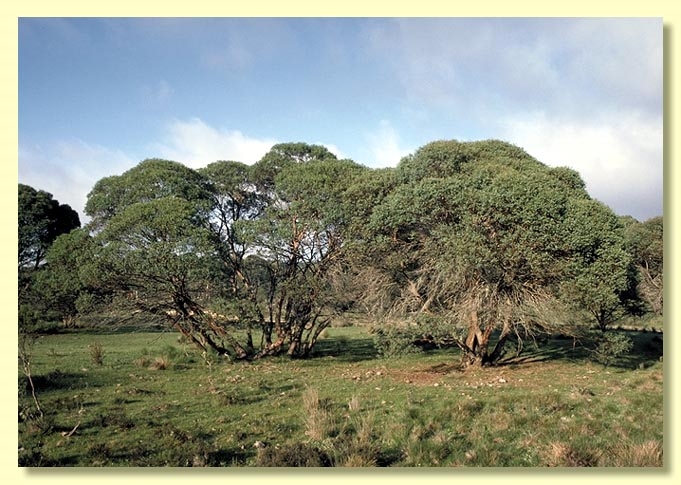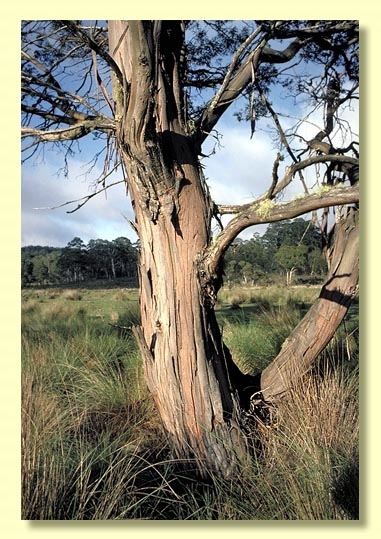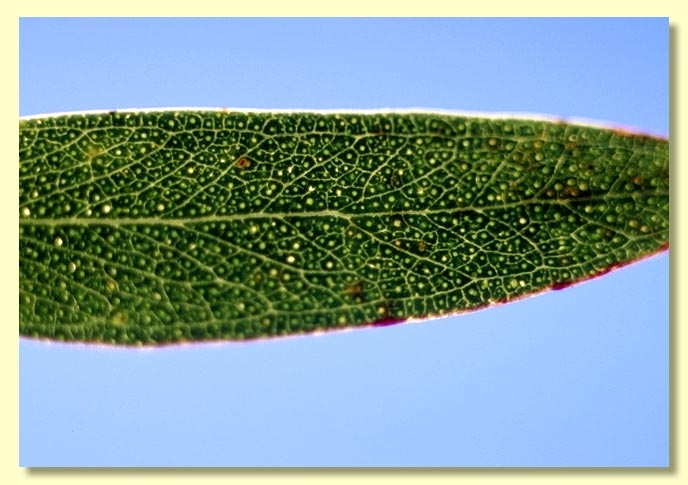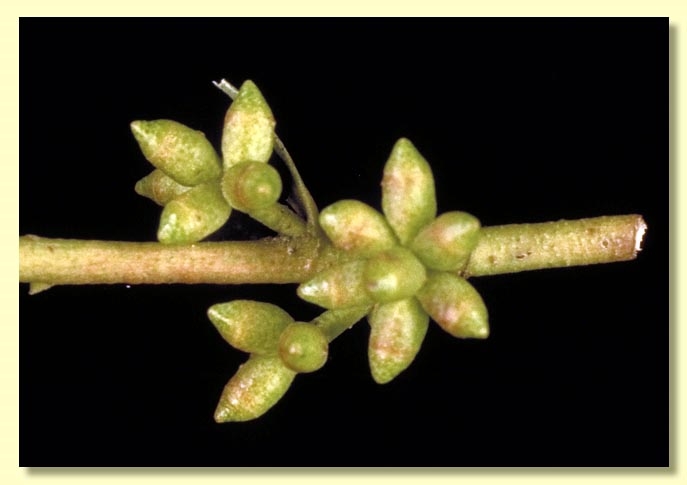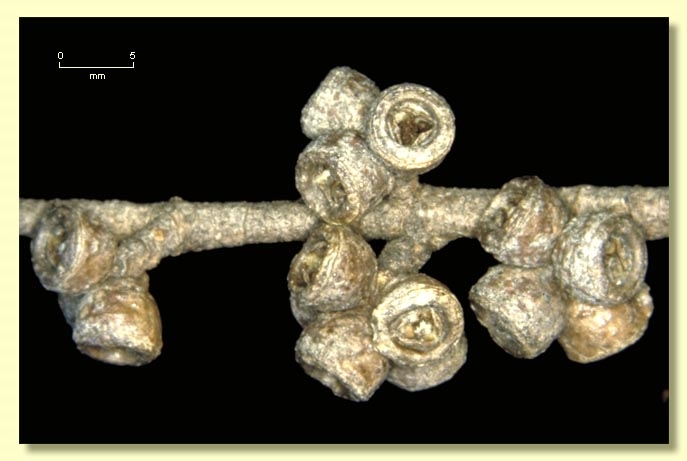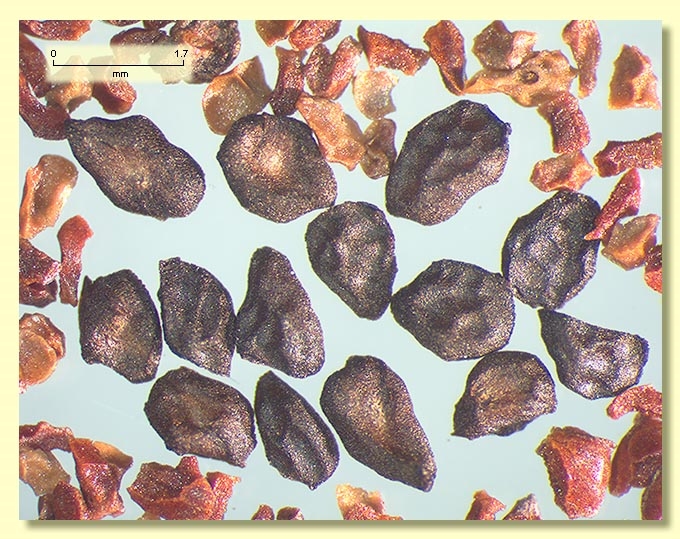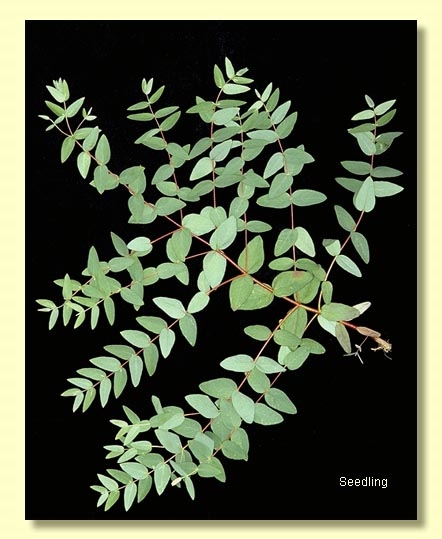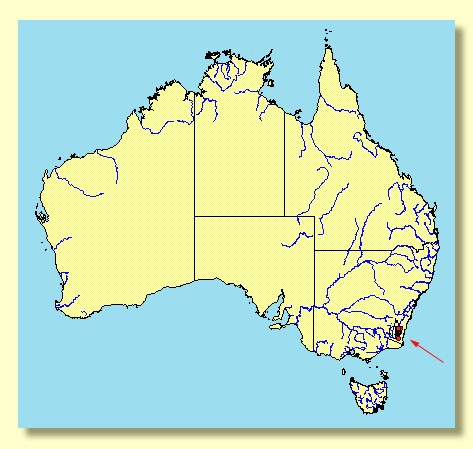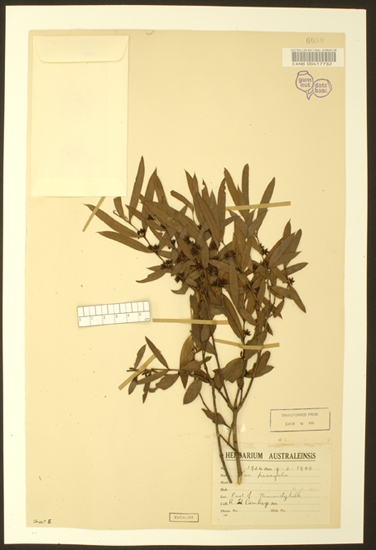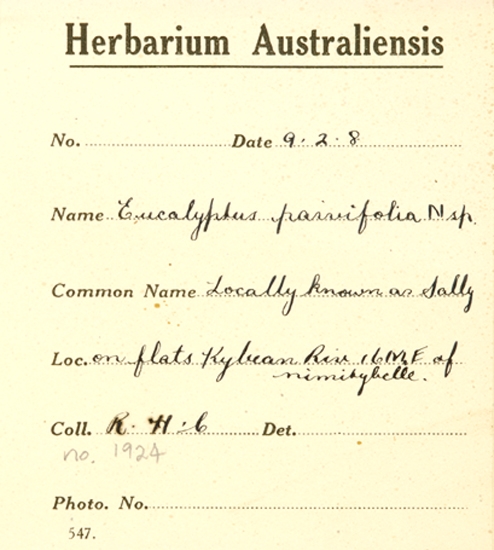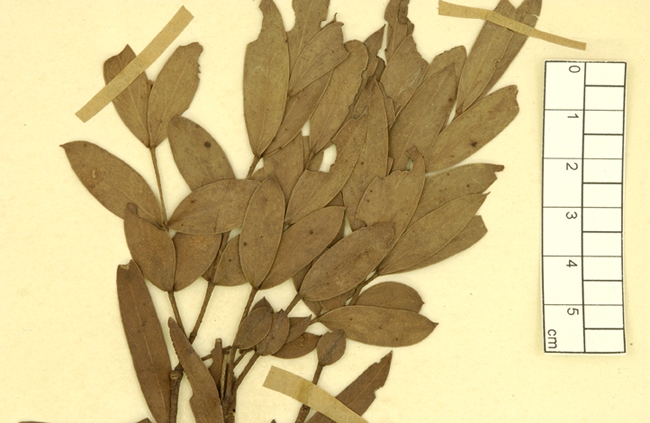Euclid - Online edition
Eucalyptus parvula
Eucalyptus | Symphyomyrtus | Maidenaria | Obscurae
Eucalyptus parvifolia Cambage, Proc. Linn. Soc., New South Wales 34: 336, t. 28, 29 (1909). T: New South Wales: Southern Tablelands: Kybean River, 16 miles [26 km] E of Nimmitabell, 9 Feb. 1908, R.H.Cambage 1924; lecto: NSW; iso: CANB.
The name Eucalyptus parvifolia was originally published in 1895 for a fossil species and thus can no longer be used for this more recently discovered living species.
Bark smooth throughout or with some persistent rough, grey bark on lower trunk; smooth bark predominantly dark grey, at times with ribbons of decorticated bark in the upper branches.
Juvenile growth (coppice or field seedlings to 50 cm): stem rounded in cross-section; juvenile leaves opposite for many pairs, sessile, elliptical to ovate or lanceolate, 1.6–4 cm long, 0.9–1.3 cm wide, green.
Crown characteristically retains large numbers of juvenile leaves, with some petiolate, lanceolate intermediate and adult leaves. Crown leaves opposite or alternate, petiole 0–0.5(1) cm long; blade elliptical to lanceolate, 3–8 cm long, 0.5–1.5 cm wide, base tapering to petiole, concolorous, dull, green, side-veins greater than 45° to midrib, moderately reticulate, intramarginal vein parallel to and just within margin, oil glands mostly island.
Inflorescence axillary unbranched, peduncles 0.2–0.7 cm long, buds 7 per umbel, sessile (sometimes central bud with 0.1 cm pedicel). Mature buds ovoid to obovoid or fusiform, smooth or slightly warty, 0.4 cm long, 0.2–0.3 cm wide, scar present, operculum conical to rounded, stamens irregularly flexed or inflexed, anthers cuboid to globoid, versatile, slits separate, style short, stigma blunt, locules 3 or 4, the placentae each with 4 vertical ovule rows. Flowers white.
Fruit sessile or rarely pedicel 0.1 cm long, cup-shaped, 0.3–0.4 cm long, 0.3–0.5 cm wide, disc raised-convex or annular to level or descending, valves 3 or 4, near rim level.
Seeds dark brown, 1–1.5 mm long, ovoid or flattened-ovoid, often lacunose, dorsal surface smooth, hilum ventral.
Cultivated seedlings (measured at ca node 10): cotyledons bilobed; stems square to rounded in cross-section; leaves sessile and opposite for many pairs, ovate, 1.5–2.5 cm long, 1–2 cm wide, base stem-clasping, margin entire, apex pointed, dull, green.
Flowering has been recorded in January.
A small tree of restricted but scattered distribution on the Southern Tablelands of New South Wales east of Cooma, from near Badja south to Dragon Swamp near Cathcart, preferring damp cold sites on grassy plains.
Eucalyptus parvula has smooth bark and small, opposite or subopposite leaves in the mature crown; however, some plants develop longer lanceolate more adult leaves that tend to become alternate. Buds and fruit are in clusters of sevens and are small and sessile. Within the genus affinities are obscure but it is probably closest to E. recurva, one of the rarest species. E. recurva differs by its mallee habit, by having much smaller leaves and three-budded inflorescences. E. parvula, like E. recurva, may not be strongly self-fertile or inter-fertile with other individuals of the same species, and it is common to find individuals in the vicinity appear to be hybrids, e.g. with E. rubida, indicated by some three-budded inflorescences and larger than normal juvenile leaves.
Eucalyptus parvula belongs in Eucalyptus subgenus Symphyomyrtus section Maidenaria, a large group of species more or less restricted to south-eastern Australia, characterised by bilobed cotyledons, simple axillary inflorescences, buds with two opercula, stamens with versatile anthers and flattened seeds with a ventral hilum. Within this section, E. parvula, with E. recurva, form the small subsection Obscurae, having smooth bark, a crown largely of opposite to sub-opposite juvenile leaves, small buds, a short style and small flat-topped fruit.
Eucalyptus parvula is listed as "Vulnerable" under the Australian Government Environment Protection and Biodiversity Conservation Act 1999 (EPBC Act). Further information may be found at this web address:
http://www.environment.gov.au/cgi-bin/sprat/public/sprat.pl

